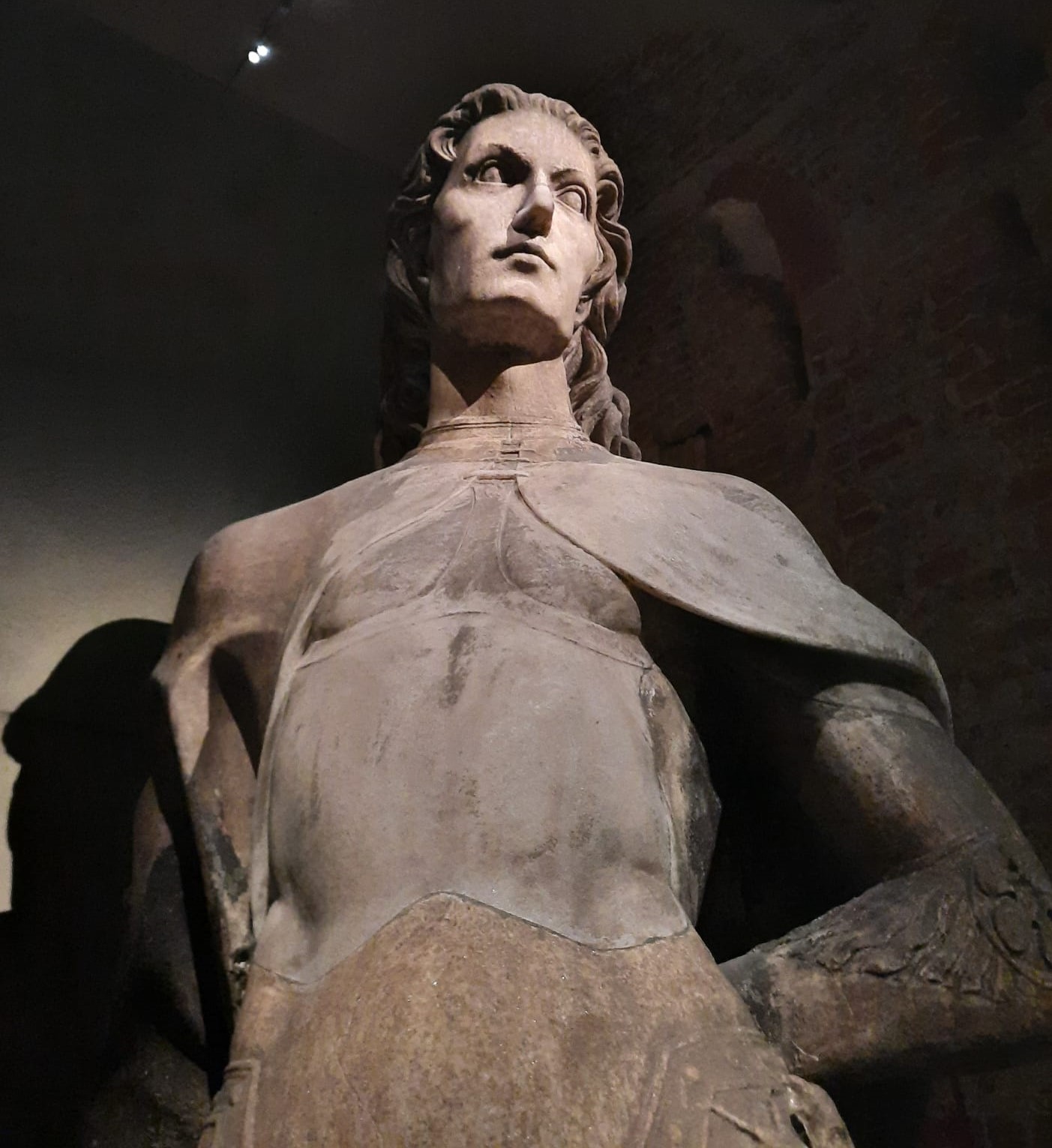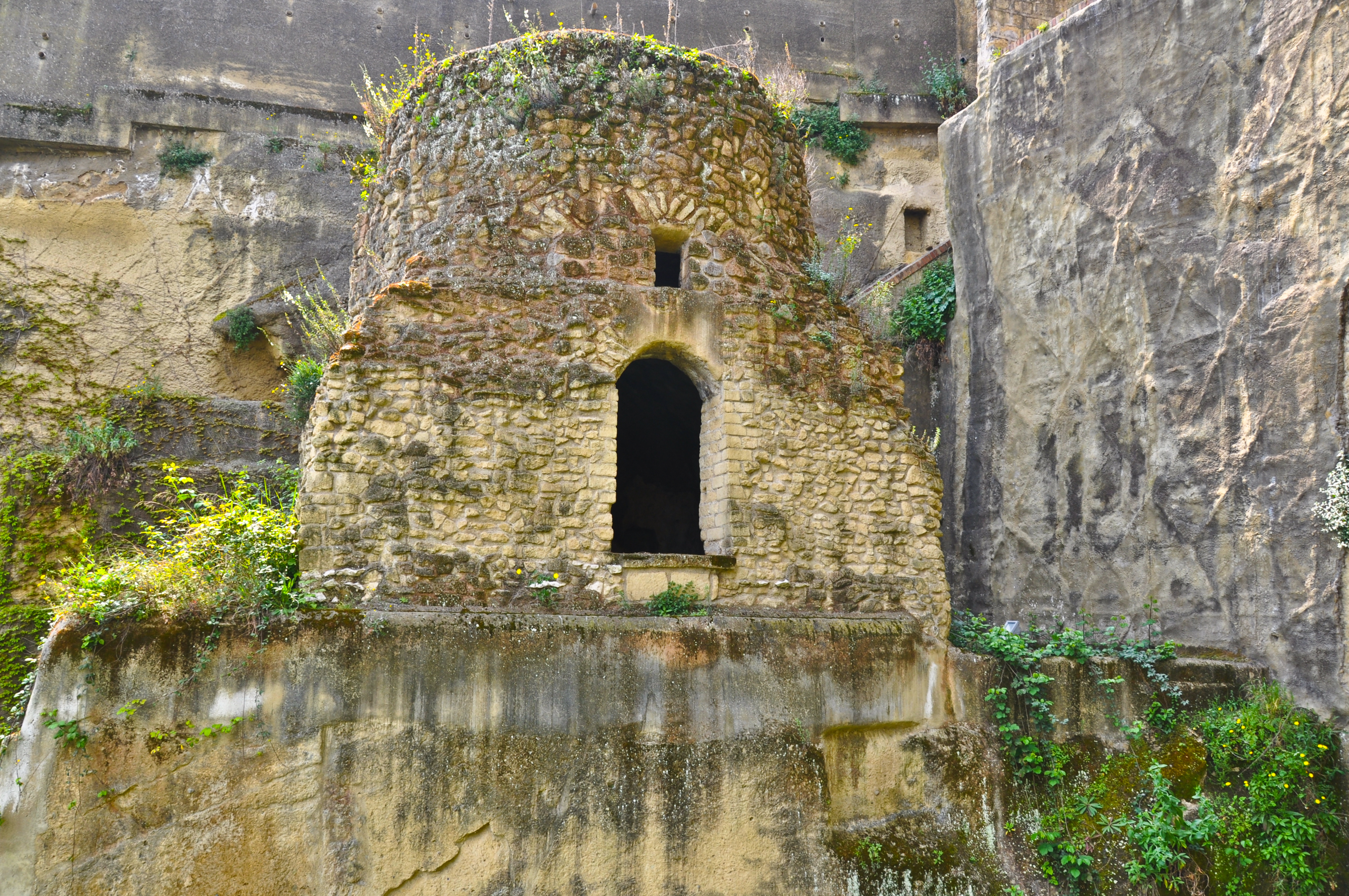|
Isabella D'Este
Isabella d'Este (19 May 1474 – 13 February 1539) was the Marchioness of Mantua and one of the leading women of the Italian Renaissance as a major cultural and political figure. She was a patron of the arts as well as a leader of fashion and her innovative style of dressing was emulated by many women. The poet Ariosto labeled her as the "liberal and magnanimous Isabella", while author Matteo Bandello described her as "supreme among women". Diplomat Niccolò da Correggio went even further by hailing her as "The First Lady of the world". She served as the regent of Mantua during the absence of her husband Francesco II Gonzaga and during the minority of her son Federico. She was a prolific letter-writer and maintained a lifelong correspondence with her sister-in-law Elisabetta Gonzaga. Isabella grew up in a cultured family in the city-state of Ferrara. She received a fine classical education and she met many famous humanist scholars and artists. Due to the vast amount of e ... [...More Info...] [...Related Items...] OR: [Wikipedia] [Google] [Baidu] |
Francesco I D'Este, Duke Of Modena
Francesco I d'Este (6 September 1610 – 14 October 1658) was Duke of Modena and Reggio from 1629 until his death. The eldest son of Alfonso III d'Este, he became reigning duke after his father's abdication. Biography Born on 6 September 1610, Francesco was the son of Alfonso III d'Este, Duke of Modena and Isabella of Savoy. After the outbreak of the Thirty Years' War he sided with Spain and invaded the duchy of Parma, but upon visiting to Spain to claim his reward, he could only acquire Correggio by a payment of 230,000 florins. Later followed the First War of Castro, in which Francesco's Modena joined Venice and Florence and sided with the Dukes of Parma against Barberini Pope Urban VIII, aiming to reconquer Ferrara. The war ended without any particular gain for the Modenese. As again no help had come from Spain, Francesco allied with France through the intercession of Cardinal Mazarin. When he however failed to conquer Cremona, and as the situation of the Thirty Ye ... [...More Info...] [...Related Items...] OR: [Wikipedia] [Google] [Baidu] |
Virgil
Publius Vergilius Maro (; 15 October 70 BC21 September 19 BC), usually called Virgil or Vergil ( ) in English, was an ancient Rome, ancient Roman poet of the Augustan literature (ancient Rome), Augustan period. He composed three of the most famous poems in Latin literature: the ''Eclogues'' (or ''Bucolics''), the ''Georgics'', and the Epic poetry, epic ''Aeneid''. A number of minor poems, collected in the ''Appendix Vergiliana'', were attributed to him in ancient times, but modern scholars generally regard these works as spurious, with the possible exception of a few short pieces. Already acclaimed in his own lifetime as a classic author, Virgil rapidly replaced Ennius and other earlier authors as a standard school text, and stood as the most popular Latin poet through late antiquity, the Middle Ages, and early modernity, exerting inestimable influence on all subsequent Western literature. Geoffrey Chaucer assigned Virgil a uniquely prominent position among all the celebrities ... [...More Info...] [...Related Items...] OR: [Wikipedia] [Google] [Baidu] |
Alfonso II Of Naples
Alfonso II (4 November 1448 – 18 December 1495) was Duke of Calabria and ruled as King of Naples from 25 January 1494 to 23 January 1495. He was a soldier and a patron of Renaissance architecture and the arts. Heir to his father Ferdinand I's Kingdom of Naples, Alfonso held the dukedom of Calabria for most of his life. In the 1480s Alfonso commanded the Neapolitan forces in Tuscany in 1478–79. He helped reverse the Ottoman invasion of Otranto in Apulia in 1480–81, and against the Republic of Venice in 1484. In 1486 Alfonso's repressive conduct towards the Neapolitan nobility prompted a revolt; the violent excesses of suppressing this uprising further discredited Alfonso and King Ferdinand. Under Alfonso's patronage the city of Naples was remodelled with new churches, straightened roads, and an aqueduct supplying fountains. Alfonso became King of Naples in 1494 on his father's death. Within a year he was forced by the approaching army of Charles VIII of Fra ... [...More Info...] [...Related Items...] OR: [Wikipedia] [Google] [Baidu] |
Sigismondo D'Este (1480–1524)
Sigismondo d' Este (September 1480 – August 9, 1524) was the youngest son of Ercole I d'Este, Duke of Ferrara, and Eleanor of Aragon, daughter of Ferdinand I of Naples. He grew up at the court of Ferrara. After his father's death, the title passed to his brother Alfonso I d'Este. He was the head of the procession Ferrara who went to Rome to take the future Duchess of Ferrara, Lucrezia Borgia, wife of Alfonso I. In contrast to Ferrante d'Este and Giulio d'Este Giulio d'Este (13 July 1478 – 24 March 1561) was the illegitimate son of Ercole I d'Este, Duke of Ferrara. He is known for the conflicts he had with his half brother, Ippolito d'Este, which culminated in a failed conspiracy. Biography In th ..., Sigismund never attempted to oppose the brothers Alfonso and Ippolito d'Este, but rather lived in their shadow. Sigismund often accompanied the Duke on his travels in and out of the duchy. When the conspiracy organized by Ferrante and Giulio was discovered, the trial a ... [...More Info...] [...Related Items...] OR: [Wikipedia] [Google] [Baidu] |
Ippolito D'Este
Ippolito (I) d'Este (; 20 March 1479 – 3 September 1520) was an Italian Roman Catholic cardinal, and Archbishop of Esztergom. He was a member of the ducal House of Este of Ferrara, and was usually referred to as the Cardinal of Ferrara. Though a bishop of five separate dioceses, he was never consecrated a bishop. He spent much of his time supporting the ducal house of Ferrara and negotiating on their behalf with the Pope. Biography Born in Ferrara, Ippolito was the son of Duke Ercole I d'Este, Duke of Ferrara, and Eleanor of Naples, daughter of Ferdinand I of Naples. His eldest brother, Alfonso became duke in 1505, and married Lucrezia Borgia. He had another brother, Ferdinando, a brother Sigismondo, and two sisters, Beatrice (who married Ludovico Sforza) and Isabella (who married Duke Francesco of Mantua). He also had a half-brother, Giulio, and a half-sister, Lucrezia. Youth From infancy Ippolito was destined for a career in the Church, and at the age of three he was ... [...More Info...] [...Related Items...] OR: [Wikipedia] [Google] [Baidu] |
Ferrante D'Este
Ferrante d'Este (19 September 1477, Castel Capuano, Naples – February 1540, Ferrara) was a Ferrarese nobleman and condottiero. He was the son of Ercole I d'Este and Eleonora d'Aragona (1450-1493), Eleonora d'Aragona - he was named after his mother's father Ferdinand I of Naples. His five siblings were Alfonso I d'Este, cardinal Ippolito d'Este, Isabella d'Este, wife of Francesco II Gonzaga, Beatrice d'Este, and Sigismondo d'Este (1480–1524), Sigismondo d'Este. His two illegitimate half-siblings were Giulio and Lucrezia d'Este. Life At Charles VIII's court He was born in Naples, where his mother had gone into seclusion. He was christened on 7 October 1477 with Giuliano della Rovere as his godfather and raised at the Aragonese court in Naples. In 1493 his father invited him to join the court of Charles VIII of France. When Charles invaded Italy, Ferrante decided not to follow the French army to Naples but remained in Rome, spending his regular allowance from his father dissol ... [...More Info...] [...Related Items...] OR: [Wikipedia] [Google] [Baidu] |
Alfonso I D'Este, Duke Of Ferrara
Alfonso d'Este (21 July 1476 – 31 October 1534) was Duke of Ferrara from 1504 to 1534, during the time of the War of the League of Cambrai. Biography He was the son of Ercole I d'Este, Duke of Ferrara and Eleanor of Naples and became duke on Ercole's death in January 1505. In the first year of his rule he uncovered a plot by his brother Ferrante and half-brother Giulio d'Este, directed against him and his other brother Ippolito. In September 1506 a trial for lèse majesté and high treason was held and, as expected, the death sentence was passed, but just as Ferrante and Giulio were about to mount the gallows they were informed that the duke had commuted their sentence to life imprisonment. They were led away to two cells in the Torre dei Leoni. Ferrante died in his cell after 34 years of imprisonment, while Giulio held on until he was pardoned in 1559, after 53 years of imprisonment. After his release, Giulio was ridiculed in the streets of Ferrara for his outdated ... [...More Info...] [...Related Items...] OR: [Wikipedia] [Google] [Baidu] |
Beatrice D'Este
Beatrice d'Este (29 June 1475 – 3 January 1497) a noblewoman from Duchy of Ferrara, Ferrara, duchess of Bari and Milan by her marriage to Ludovico Sforza (known as "Ludovico il Moro"). She was known as a woman of culture, an important patron of arts and science and a leader in fashion: alongside her husband, she made Milan one of the greatest capitals of the European Renaissance. With her determination and bellicose nature, she led the Milanese resistance against the French during the Italian War of 1494–1495, first of the Italian Wars. Her interventions repelled the Louis XII, Duke of Orléans who was on the verge of conquering Milan.; ; ; ; . Life Childhood Birth and childhood in Naples (1477–1485) She was born on 29 June 1475 in the Castello Estense in Ferrara as the second child of Ercole I d'Este and Eleanor of Naples, Duchess of Ferrara, Eleanor of Aragon. As his father did not yet have a male heir, Beatrice's birth was a disappointment to her family and the c ... [...More Info...] [...Related Items...] OR: [Wikipedia] [Google] [Baidu] |
Isabella Of Clermont
Isabella of Clermont ( – 30 March 1465), also known as Isabella of Taranto, was queen consort of Naples, Queen of Naples as the first wife of King Ferdinand I of Naples, and a feudatory of the kingdom as the holder and ruling Princess of the Principality of Taranto in 1463–1465.Marcello Moscone, Isabella Chiaramonte, Regina di Napoli, Dizionario biografico degli italiani, vol. 62, 2004. Life Born on January 1424 in Copertino (in southern Apulia), Isabella was the elder daughter of Tristan de Clermont, Count of Copertino, and Catherine of Taranto, Countess of Copertino, Caterina Orsini Del Balzo. She was also the niece and heir of childless Giovanni Antonio Orsini del Balzo, Prince of Taranto. Her maternal grandmother, Mary of Enghien, was queen consort of Naples from 1406 until 1414. On 30 May 1444/1445, Isabella married Ferdinand I of Naples, Ferdinand of Aragon, then Duke of Calabria (1423–1494), natural son of Alfonso V of Aragon who had recently conquered the Neapolit ... [...More Info...] [...Related Items...] OR: [Wikipedia] [Google] [Baidu] |
Ferdinand I Of Naples
Ferdinand I (2 June 1424 – 25 January 1494), also known as Ferrante, was king of Naples from 1458 to 1494. The only son, albeit illegitimate, of Alfonso the Magnanimous, he was one of the most influential and feared monarchs in Europe at the time and an important figure of the Italian Renaissance. In his thirty years of reign, he brought peace and prosperity to Naples. Its Foreign policy, foreign and diplomatic policy aimed at assuming the task of regulating the events of the peninsula in order not to disturb the political balance given by the Treaty of Lodi, to affirm the hegemony of the Kingdom of Naples over the other List of historic states of Italy, Italian states and to tighten through its diplomats and marriages of his numerous legitimate and natural children, a dense network of alliances and relationships with Italian and foreign sovereigns, earned him the fame and the nickname of "Judge of Italy", in addition to being recognized as a generous Patronage, patron. He iss ... [...More Info...] [...Related Items...] OR: [Wikipedia] [Google] [Baidu] |




